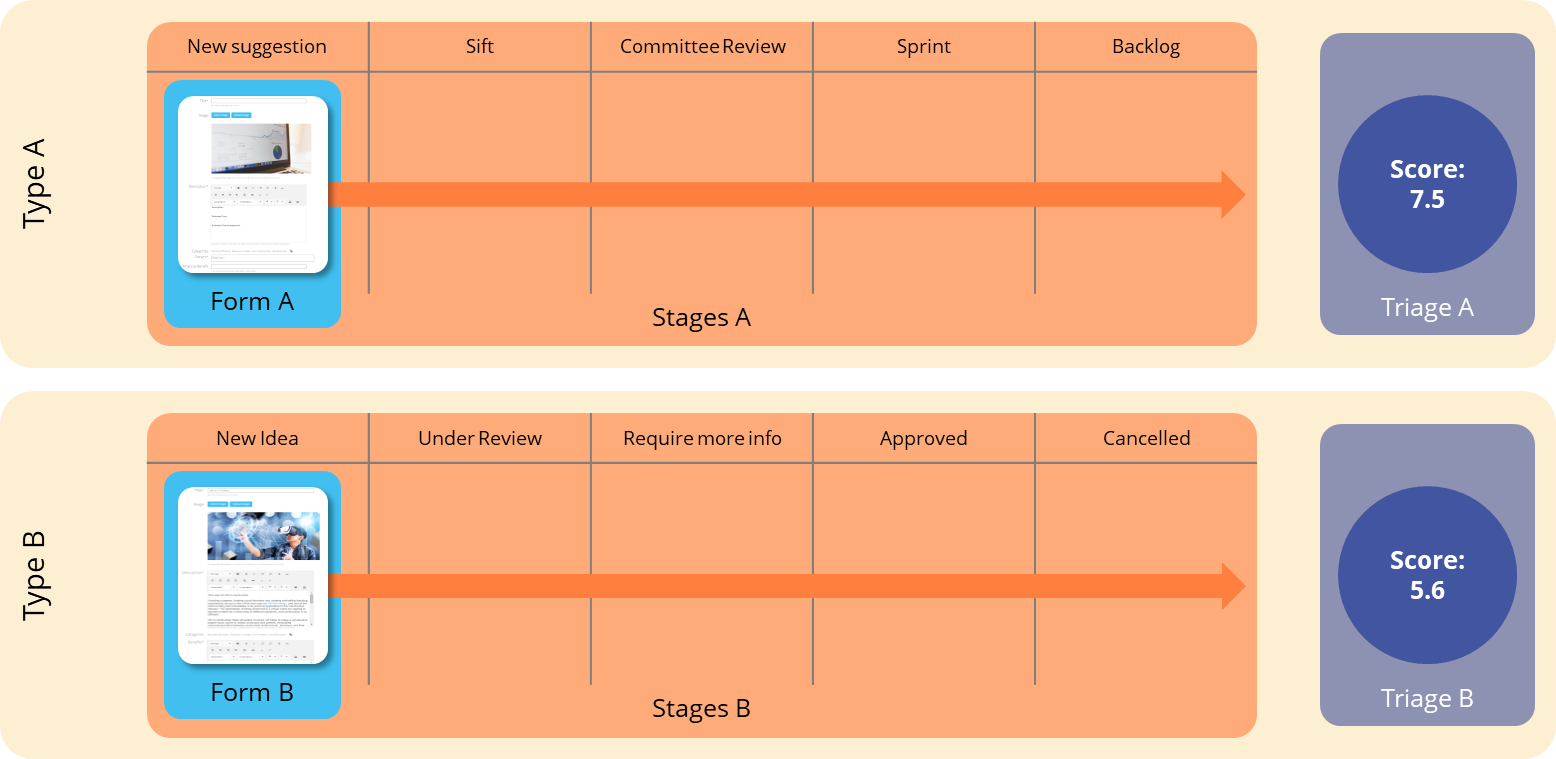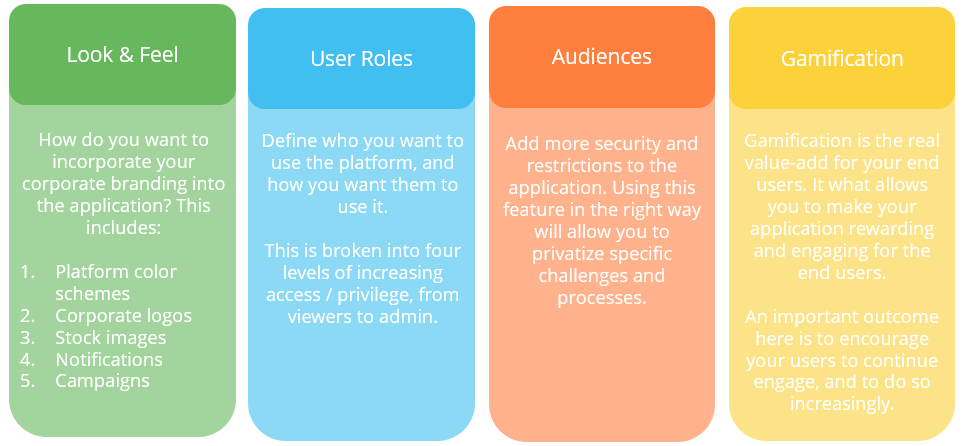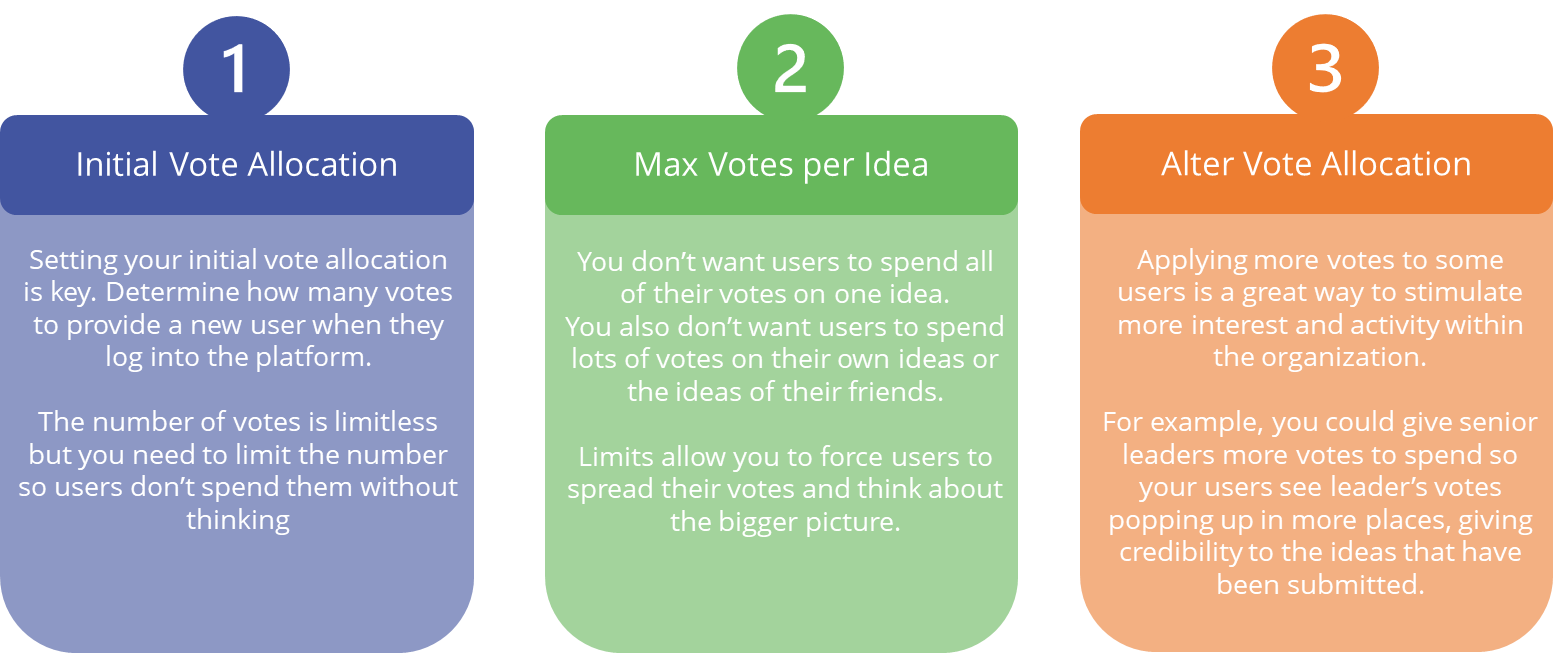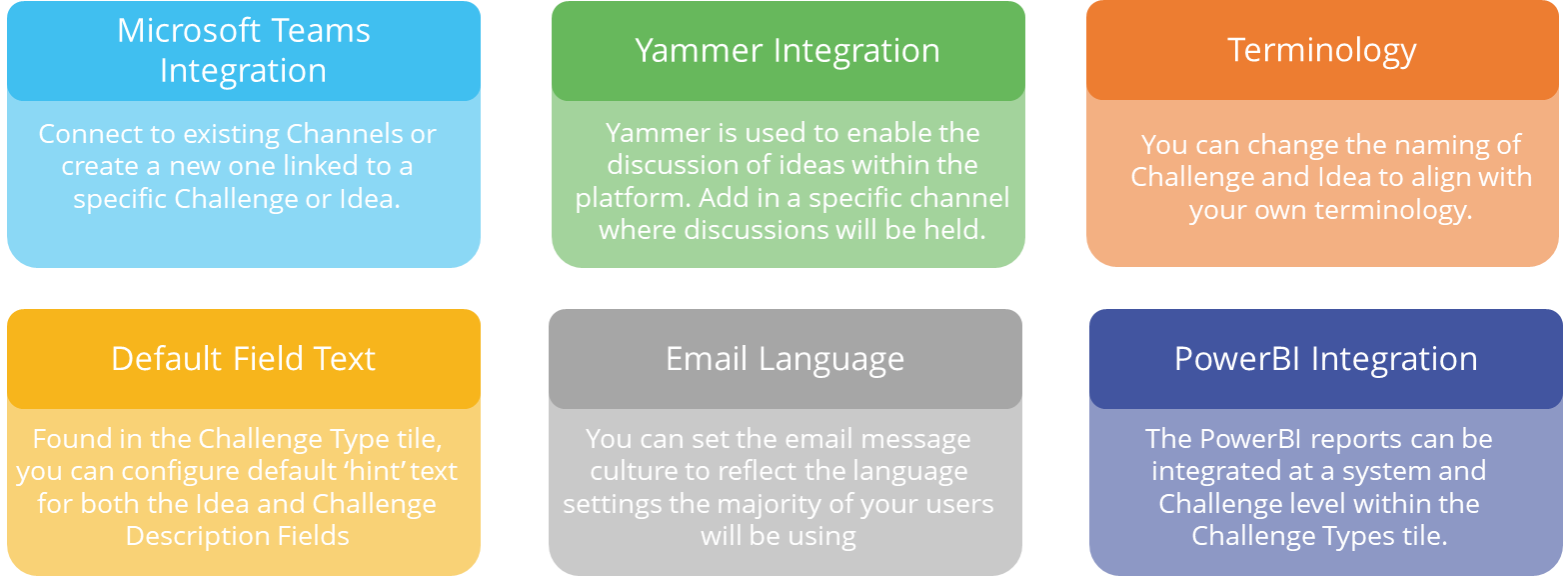All the info you need to get to grips with understanding, configuring and modifying the app.
Key Components
Challenges & Ideas
edison365ideas is a challenge-led ideation platform. Challenges are set by the business, and ideas are submitted in response to those challenges. Challenges and ideas are captured through forms, which are comprised of a number of different fields.

Forms & Fields
Fields are individual pieces of information that users must provide when completing a form. A form is a collection of fields.
Think about what data you are asking for. Do you need to reflect this information in your report?

Stages
Stages are the steps that make up your process. We recommend keeping these simple! Your strategy and governance will drive this. Below are some suggested steps for you to consider.

Triage
An essential stage of the process is getting feedback from subject matter experts. Here, the triage function is used to assign reviewers to submissions and facilitate that process through a set of criteria that you define. The triage process is a quick, efficient way to crowdsource comparable feedback quickly.

Types
Types are the top-level containers for forms, stages and triage metrics. Different types let you respond to different processes and needs within the same instance.

Configuration Guidance
The configuration of the application falls into two key areas:
1. Essential configuration
Core components, critical for usability and functionality. Decisions are required here for initial setup.
2. Secondary configuration
The remaining elements. Important functionality, but not essential for initial setup
Essential Configuration
The Key Ingredients
These essential components we need to focus on and get right as part of the essential configuration - each relate to how the platform will function and align with your own strategy and governance models.

Types
Types allow you to have differing and distinct governance and process models within the same application. For example, you may have different departments that have different processes and different governance models yet both want access and use of the platform. Types enable you to achieve this separation.

The more Types you configure, the greater the complexity.
For every new Type you will have new stages, triage metrics, fields and forms. Our tip: try and keep as many similarities as possible. Not just for configuration, but also for consistency in reporting.
Focus on getting one Type complete and fully configured to ensure you have a solid foundation, then build complexity from here.
Stages
The Stages of your process are the individual steps a submission must go through to be considered right for investment and continued efforts. You can have as many stages as you wish but our recommendation would be to keep things simple: five to eight stages work best.

Below is an example process map that shows the stages and dependencies an idea, concept or initiative can go through. It is key to understand that the process doesn’t have to be linear and that there are key decision points that need to be included.

Triage
As with stages, we can have different Triage types depending on which Challenge Type we are configuring. Triage is usually a new concept for our customers, so we have provided some useful hints on how to best approach it.

Triage can happen at any stage in your process. It is completely up to you how and when this happens. However, it is key that some governance and control is applied to your approach. It’s also important that you assign reviewers to carry out the Triage process
Key Terms
- Triage - all about decision-making and prioritization. This functionality enables you and your team to make quick, confident decisions on which ideas, concepts and initiatives should be progressed.
- Metrics - the individual criteria that ideas, concepts and initiatives are measured against.
- Invert - Change the signality of the score. By default, a higher score = better outcome. However, for elements like “Risk”, where high risk is a worse outcome, we can change the direction of the slider.
- Weighting - alter the importance of each metric. This is used to indicate where a metric is less or more important than another.
- Boundaries - represent the answers that your reviews can give. They represent discrete positions on a sliding scale and determine how your reviewers can respond.
Triage - Key Considerations
- You have a maximum of 8 Metrics you can configure into each Triage Type.
- Think about what feedback you want to draw from each metric. What is key to understand from reviewers analyzing each idea?
- Use the ‘Metric Hint’ functionality to tell your reviewers what you expect from them.
- Keep it simple. Don’t overcomplicate the process at first with different weightings and lots of Metrics.
- Consider and understand how you will use the Boundaries. How many Boundaries do you need? How granular do you need to be?
- Think about the User Experience. Make the process clear and easy to understand. Think about using the ‘Default’ Metric function to pre-set the boundaries and think about the order of your Metrics.
Below are some examples of different approaches to triage along with some useful visuals highlighting the different Key Terms we saw on the previous page.



Fields & Forms
Categories are a special field that provide some key system configuration benefits such as…

Custom Field Types
Below is the full list of custom field types you are able to configure within the platform.

Fields - Examples


Secondary Configuration
The Key Ingredients
The secondary configuration elements are the remaining configuration items that tie all of the essential configuration elements together whilst applying the finishing touches to the platform.

Look & Feel
Key Considerations
- Start by looking at both design modes. Design mode 1 provides the most information on cards but less color flexibility, whilst design mode 2 provides more color flexibility but less detail.
- Experiment with the primary, secondary and tertiary color ways to see what works with your brand requirements.
- Campaigns are a powerful way of introducing more branding and messaging. Use them often!
- Make sure you use logo and banner images that meet the dimension criteria.
edison365 is a SaaS product and, although configurable, cannot be fully changed to meet your needs.

Email Notifications
Key Considerations
- Owners of ideas and challenges are automatically subscribed to email notifications. Is this a feature you need?
- Email notifications are system-wide. Your configuration is applied across all notifications.
- When providing a banner URL, ensure that your end users also have access to the source image. If it’s private, they won’t see it.
- Use the email signature to personalize your communications with your end users for maximum engagement.
‘Status Changed’ is the key notification for users when their idea changes stage. Any comments or stage description will show up in the email so think about the descriptions you are applying to your stages.
User Roles
A three-step process
There are 4 distinct User Roles in edison365ideas. Each of these roles provide different levels of responsibility in the application and can be selected in the Admin Panel once the user registration process is followed.

Audiences
Audiences is edison365idea’s inbuilt security system - it allows you to restrict access to certain Challenge Types and certain Challenges. Below is how it works and how it can benefit you.

Gamification
Gamification has two primary benefits: end user engagement, and performance analysis. From the front end, gamification provides end users with rewards and stimulation in response to their engagement and activity. Data is captured for each interaction in the platform, allowing you to report on behavior and engagement across your portfolio. There are three main components of the gamification functionality:

Points
“Points are for people”! Points let you to automatically recognize individuals for their involvement in the application. There are three key considerations for leveraging the power of points.


Awards
As we know, points are awarded to those that have interacted with the platform. These points allow users to achieve Medals and Levels. These accumulated Points can also be used by the User to spend on an Award that is set by the administrators of the platform. The configuration of Awards enables you to really embed high impact reward and recognition directly into the application, simplifying the process of award, notification and management.

Awards - Key Considerations
- What type of Award are you providing? Monetary? Personal? Novelty? All this needs to be decided and clear in the Title and Description.
- How easy should it be to achieve this award? There should be a balance of effort and ease. Users need to be able to achieve awards, but they need to work for it to get that sense of achievement that keeps them coming back for more. The Points Required allows you to set this threshold.
- How many of these Awards do you want to exist and be claimed? Is it a one off or is this a regular thing you want users to claim?
- Do you want users to come back for the same reward time and time again? Or is this a one-time deal?
Votes
Votes act as ‘digital currency’ that allow users to spend on the ideas they deem most worthy. These votes also indicate priorities at a strategic level, and encourage your organization to think hard about time, cost, resource and more – as their votes are finite.

Final Considerations
There are some additional components to look into when finalizing your secondary configuration. Many of the below items will be found in the ‘system configuration’ tile in the Admin Panel.

